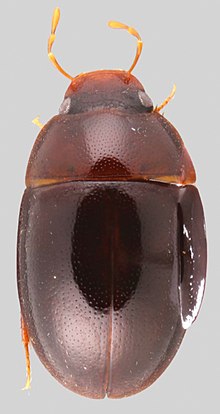Crucisternum is a Neotropical genus of water scavenger beetle in the family Hydrophilidae represented by seven described species known from the Guiana Shield Region.[1]
| Crucisternum | |
|---|---|

| |
| Dorsal view of Crucisternum ouboteri | |
| Scientific classification | |
| Kingdom: | |
| Phylum: | |
| Class: | |
| Order: | |
| Family: | |
| Subfamily: | |
| Genus: | Crucisternum Girón & Short, 2018
|
| Diversity | |
| 7 species | |
Taxonomy
editThe genus Crucisternum was described for the first time by Girón & Short in 2018.[2]
It belongs in the subfamily Acidocerinae and contains seven described species from Brazil (Minas Gerais, Pará), French Guiana, Guyana, Suriname, and Venezuela.[1][2]
Description
editSmall beetles (2.0–2.5 mm), smooth and shiny dorsally, orange-brown to dark brown in coloration, with long maxillary palps. The most salient characteristic of the genus is the presence of a longitudinal carina on the prosternum, which is accompanied by a cruciform elevation on the mesoventrite. A complete diagnosis was presented by Girón and Short.[1][2]
Habitat
editAccording to Girón and Short "All species of the genus are associated with forested streams, usually along margins that contain ample detritus".[1]
Species
edit- Crucisternum escalera Girón and Short, 2018
- Crucisternum ouboteri Girón and Short, 2018
- Crucisternum queneyi Girón and Short, 2018
- Crucisternum sinuatus Girón and Short, 2018
- Crucisternum toboganensis Girón and Short, 2018
- Crucisternum vanessae Girón and Short, 2018
- Crucisternum xingu Girón and Short, 2018
References
edit- ^ a b c d Girón, Jennifer C.; Short, Andrew Edward Z. (2021-06-18). "The Acidocerinae (Coleoptera, Hydrophilidae): taxonomy, classification, and catalog of species". ZooKeys (1045): 1–236. Bibcode:2021ZooK.1045....1G. doi:10.3897/zookeys.1045.63810. ISSN 1313-2970. PMC 8233300. PMID 34228772.
- ^ a b c Girón, Jennifer C.; Short, Andrew Edward Z. (2018-06-19). "Three new genera of acidocerine water scavenger beetles from tropical South America (Coleoptera, Hydrophilidae, Acidocerinae)". ZooKeys (768): 113–158. Bibcode:2018ZooK..768..113G. doi:10.3897/zookeys.768.24423. ISSN 1313-2970. PMC 6019434. PMID 29955215.